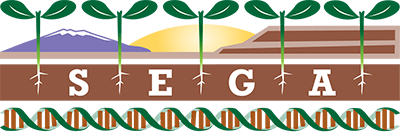You are here
How will climate change affect high elevation bees?

In the mountains of the southwest pollination is often carried out by Megachilidae bees, adapted to high elevations and cool temperatures. But what will happen as climate change brings warmer conditions to higher and higher elevations?
You may not have heard of Megachilidae bees – but you’ve almost certainly seen their effects. They are among the world’s most efficient pollinators – so much so that some species are sold commercially for that purpose. That’s because their motion inside the reproductive structures of flowers is highly energetic and swimming-like - releasing large amounts of pollen.
This cosmopolitan family of bees – commonly known as ‘mason bees’ or ‘leafcutter bees’ are usually solitary and rather than carrying pollen on their hind legs like most other bees, they carry their pollen in a pocket or ‘scopa’ on the underside of their abdomens. There are many native species of Megachilidae in the mountains of the US southwest – some of which are very specific to high elevation habitats where they rely on dead wood to provide them with nest sites.
But what will happen as climate change brings warmer conditions to higher and higher elevations? Can these species move up the elevation gradient before their current habitat becomes unsuitable? This question is being investigated by NAU graduate student Lindsie McCabe, supervised by Neil Cobb at the Merriam-Powell Center for Environmental Research. The study is looking at 21 Megachilidae forest and woodland bee species at three SEGA forest sites on Grand Canyon Trust land in the North Kaibab Fores, along with pinyon juniper, ponderosa, mixed conifer and spruce fir sites on the San Francisco peaks.
The study is focusing on experimentally assessing temperature as a key limiting factor with 3 main aims:
1. To test for rapid adaptation of immature bee species when they’re moved out of their current range.
2. To assess the fluctuation of temperature in bee blocks during their larval stages.
3. To examine whether temperature or nesting substrate is the dominate limitation for these species.
In a simple but elegant experimental design, McCabe has placed bee nesting boxes at all these sites and will move some of them between elevations to simulate climate change.
It’s too early for any results from this study. But you can hear a short piece on this study on KNAU’s Brain Food feature by following this link:
http://knau.org/post/brain-food-can-high-elevation-bees-adapt-climate-change#stream/0
You may not have heard of Megachilidae bees – but you’ve almost certainly seen their effects. They are among the world’s most efficient pollinators – so much so that some species are sold commercially for that purpose. That’s because their motion inside the reproductive structures of flowers is highly energetic and swimming-like - releasing large amounts of pollen.
This cosmopolitan family of bees – commonly known as ‘mason bees’ or ‘leafcutter bees’ are usually solitary and rather than carrying pollen on their hind legs like most other bees, they carry their pollen in a pocket or ‘scopa’ on the underside of their abdomens. There are many native species of Megachilidae in the mountains of the US southwest – some of which are very specific to high elevation habitats where they rely on dead wood to provide them with nest sites.
But what will happen as climate change brings warmer conditions to higher and higher elevations? Can these species move up the elevation gradient before their current habitat becomes unsuitable? This question is being investigated by NAU graduate student Lindsie McCabe, supervised by Neil Cobb at the Merriam-Powell Center for Environmental Research. The study is looking at 21 Megachilidae forest and woodland bee species at three SEGA forest sites on Grand Canyon Trust land in the North Kaibab Fores, along with pinyon juniper, ponderosa, mixed conifer and spruce fir sites on the San Francisco peaks.
The study is focusing on experimentally assessing temperature as a key limiting factor with 3 main aims:
1. To test for rapid adaptation of immature bee species when they’re moved out of their current range.
2. To assess the fluctuation of temperature in bee blocks during their larval stages.
3. To examine whether temperature or nesting substrate is the dominate limitation for these species.
In a simple but elegant experimental design, McCabe has placed bee nesting boxes at all these sites and will move some of them between elevations to simulate climate change.
It’s too early for any results from this study. But you can hear a short piece on this study on KNAU’s Brain Food feature by following this link:
http://knau.org/post/brain-food-can-high-elevation-bees-adapt-climate-change#stream/0
Theme by Danetsoft and Danang Probo Sayekti inspired by Maksimer
